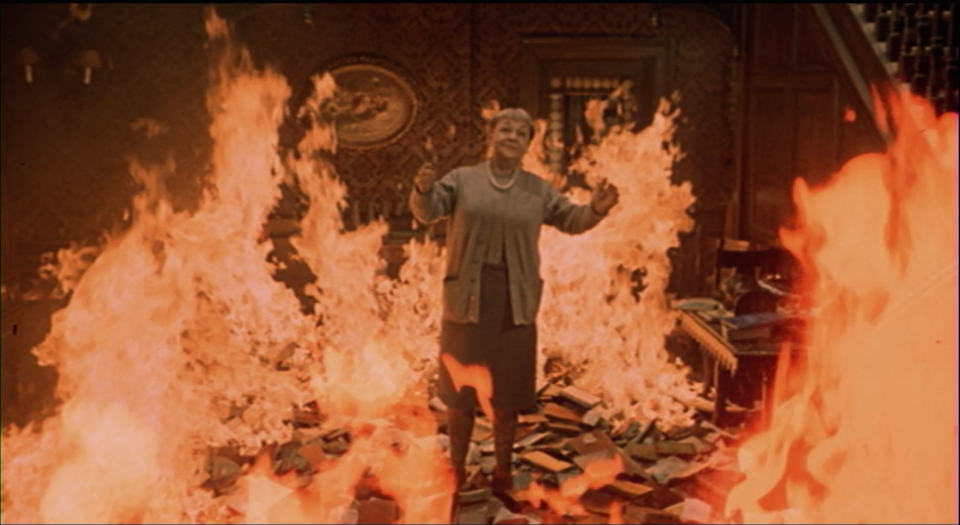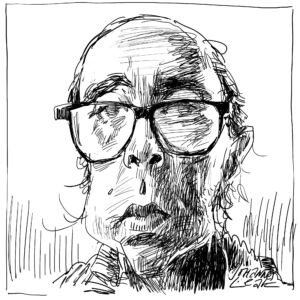
Long-read
Bradbury: between dystopia and hope
A new study of Ray Bradbury reminds us how much the author of Fahrenheit 451 believed in humanity.
Want unlimited, ad-free access? Become a spiked supporter.
Ray Bradbury was a paradoxical kind of visionary, both enthused and terrified at what lay ahead for humanity. He spoke with great optimism about man’s capacity to create his own destiny, through scientific progress and space exploration. Yet his science fiction depicted a future marked by ambivalence, pessimism or outright horror.
Bradbury’s three best-known works encapsulate these various strands of gloom. His masterpiece, Fahrenheit 451 (1953), ranks alongside Brave New World and Nineteen-Eighty Four as a giant of 20th-century dystopiana, imagining a world in which firemen burn books and the dangerous ideas contained within them. Before it, The Illustrated Man (1951) anthology mixes anxiety-laden tales with horror stories of technology unleashed – Frankenstein for the atomic age.
Then there was The Martian Chronicles (1950). In this short-story collection, human settlers on the Red Planet end up diseased, homesick, neurotic, mad or dead. The explorers, driven from Earth not by an optimistic desire to seek new worlds, but by nuclear war and tyranny, are destined to ruin the new planet as they did the old. ‘We Earth Men have a talent for ruining big, beautiful things’, says one trooper in the story ‘And the Moon be Still as Bright’: ‘The only reason we didn’t set up hot-dog stands in the midst of the Egyptian temple of Karnak is because it was out of the way and served no large commercial purpose.’ Man can leave his own planet, but he can never escape himself.
In real life, however, Ray Bradbury was a well-known and vocal advocate of the liberating potential of space exploration. Alongside Arthur C Clarke and Isaac Asimov, he has been hailed by NASA historians as a visionary without whom the space programme would not have been possible. Here was a figure who affirmed in 1980 that ‘machines, if properly built, can carry our most fragile dreams through a million light-years of travel without breakage. Such machines, and the shuttle with them, are the armour of our life force.’ Bradbury had a vision of future in which space exploration would play a central, redemptive, role. Of humanity’s destructive tendencies, he replied rhapsodically, ‘so much more reason then to cultivate our gardens in space, invite ourselves back in through the gates of time and travel, and establish ourselves not just beyond the Moon but beyond Mars and beyond Pluto and, finally, beyond death’.
The discrepancy between Bradbury the ethereal prophet of the future, and the Bradbury who depicted calamity and doom, may be explained twofold. First of all, he was as much a horror writer as an author of science fiction; like Mary Shelley, he brought the Gothic into the near-now. The stories contained in The Illustrated Man can’t but help to arouse comparisons to MR James or Philip K Dick at his most paranoid.
In stories such as ‘The Fox and The Forest’, ‘The Visitor’ and ‘Marionettes, Inc’, the boundary between human and android, or real and hallucinatory, is breached to disturbing effect; in ‘The Playground’ a man is condemned forever to be a tormented child version of himself. ‘This is Hell, this is Hell!’ he cries at the end. ‘And no one in the hot, milling heap contradicted him.’ We remember Bradbury at his most terrifying because he was a master at it.
But just as George Orwell wrote Nineteen Eighty-Four as a warning rather than a prediction, Bradbury also had a concerned eye on the present. In Fahrenheit 451, he envisaged an age when ‘firemen’ would burn books because he was alarmed at contemporary censorship in America, that is, by the very notion that written words could be adjudged dangerous and damaging. We may see his tales as cautionary, not clairvoyant. Bradbury was optimistic by instinct but not by conviction.
As David Seed observes in this meticulously researched and affection tribute to the author, ‘Bradbury conceived his early science fiction as a cumulative early warning system against unforeseen consequences’. As the author himself said: ‘technological science fiction, as put in motion by human beings, can either shackle us with the greatest totalitarian dictatorship of all time, or free us to the greatest freedom in history. I mean to work for the latter in my science-fiction stories.’
Like the best writers who imagine the worlds of tomorrow, Ray Bradbury talks to contemporary society. The Martian Chronicles features a tale of America’s ‘niggers’ parting en mass by rocket to the Red Planet to escape racism and servitude in the United States, in their own kind of ironic Mayflower. This story speaks to readers now as much as it would have 70 years ago. While the recurrent themes in The Martian Chronicles of environmental catastrophe and the perils of colonisation will resonate with concerned minds today, they spoke foremost to 1950s readers for whom the Dust Bowl was in living memory. It’s no coincidence that Bradbury gives his colonies on Mars mid-Western names such as Ohio or Illinois.
Thus another ostensibly paradoxical aspect of Bradbury is the deep nostalgia contained within his future visions. As Seed notes, this is because, for Bradbury, Mars serves a metaphor for America itself, containing all the ambivalence of that one-time virgin land of discovery and freedom. Bradbury’s mixed feelings concerning Mars and the future reflects America’s own difficult relationship with itself and its past, at once the fresh, new frontier yet also a colony marked by racism and ethnic strife.
Fahrenheit 451 was launched upon a world in which book burning was in living memory. It also emerged in a United States that was distressed about Communism and what its citizens were reading or watching. Fahrenheit 451 also speaks of, and to, a culture that was becoming more superficial and philistine, in which television screens cover entire walls, where, in the words of the fire-chief Beatty: ‘School is shortened, discipline relaxed, philosophies, languages dropped, English and spelling gradually neglected… Life is immediate… Why learn anything save pressing buttons, pulling switches.’ Bradbury had expressed his disquiet at ‘the great centrifuge of radio, television, pre-thought-out movies, and so forth. Give us no time to “stop and stare”.’ How prescient these words and Fahrenheit 451 sound today, in a 21st century of shrinking attention spans and the proliferation of electronic screens.
The best dystopian science fiction is that which still speaks to the readers of tomorrow: us. In Brave New World, Aldous Huxley envisaged how ‘soma’ became a soft totalitarian tool, which today brings to mind the ‘happiness industry’ with all its shrinks and pharmaceutical salesmen who see unhappiness as a problem or a disorder.
Ray Bradbury’s Fahrenheit 451 also reminds us of the symbiotic relationship between authoritarianism and utilitarianism, for the dangers of driving for universal happiness. Regarding the need for book burning, Beatty elaborates: ‘Coloured people don’t like Little Black Sambo. Burn it. White people don’t feel good about Uncle Tom’s Cabin. Burn It’ He continues: ‘You must understand that our civilisation is so vast that we can’t have our minorities upset and stirred. Ask yourself, What do we want in this country, above all? People want to be happy, isn’t that right?… That’s all we live for, isn’t it? For pleasure and titillation? And you must admit our culture provides plenty of these.’ Here, the desire for the happiness of all demands the silence of people who rock the boat.
Western culture in 2016 has developed an idea that happiness, safety and comfort are primary goals, and that unhappiness and discomfort are anathemas. To cause offence to a person, to hurt his or her feelings, or question his or her sense of worth – these have become grievous social transgressions. Trigger warnings, Safe Spaces and Twitterstorms against people who say inappropriate things – these are manifestations of our culture’s belief that comfort and safety are paramount.
Forever trying to be the optimist, Ray Bradbury couldn’t but help demand vigilance about the future. He was like Orwell: a progressive who banefully acknowledged man’s flawed nature, his timeless thirst for power, forever wanting to push people around and tell others what to do and what to say. And, as with Orwell, Bradbury recognised that tyranny is at its most potent when it’s superficially most benevolent, when it dresses up coercion and censorship in kindly, caring language. A society that believes it paramount to keep its citizens safe, happy and comfortable for the greater good can not, and will not, tolerate dangerous words.
Patrick West is a spiked columnist. Follow him on Twitter: @patrickxwest
Ray Bradbury, by David Seed, is published by the University of Illinois Press. (Buy this book from Amazon(UK).)
You’ve read 3 free articles this month.
Support spiked and get unlimited access.
Help us hit our 1% target
spiked is funded by readers like you. It’s your generosity that keeps us fearless and independent.
Only 0.1% of our regular readers currently support spiked. If just 1% gave, we could grow our team – and step up the fight for free speech and democracy right when it matters most.
Join today from £5/month (£50/year) and get unlimited, ad-free access, bonus content, exclusive events and more – all while helping to keep spiked saying the unsayable.
Monthly support makes the biggest difference. Thank you.







Comments
Want to join the conversation?
Only spiked supporters and patrons, who donate regularly to us, can comment on our articles.